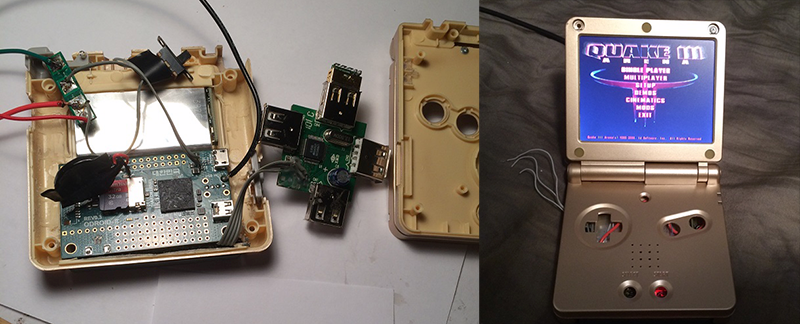What do you get when you take an extremely small Raspberry Pi clone and stuff it inside a Game Boy Advance SP? We don’t know what to call it, but it’s probably one of the best portable gaming machines ever made, able to run emulators ranging from the Apple II to playing Quake III natively on a tiny flip-top display.
This isn’t the first time we’ve seen [frostedfires]’ work on a tiny system stuffed into a Game Boy. The initial post on this build over on the bacman forums just covered the basics – getting an Odroid W up and running, and putting Quake III on the tiny display. Now that the build is complete, we can get a look at what it takes to turn a Raspberry Pi clone into one of the smallest portable projects we’ve ever seen.
Using a Raspi clone as the only component in a tiny portable emulation station isn’t possible, so [frostefires] added a few other bits of electronics to make everything work. There’s a joystick from a PSP in there to work as the mouse, a few extra buttons in addition to the stock Game Boy ones, A USB hub, WiFi adapter, speaker and amplifier, a battery and the related charging electronics, and a Teensy 3.1 to handle all the input.
It’s a very impressive build that can run emulators ranging from the Apple II to later generation Nintendo consoles and handhelds (including the Game Boy Advance), but since the HDMI connector is availble on the outside of the case, [frostedfires] can also use this as a tiny, portable media center. Check out the video below to see this Game Boy in action, playing Mario Kart and 1080p video.

















Another great post Brian. Keep up the good work!
http://hackaday.com/2014/11/19/a-raspberry-pi-in-a-game-boy-advance-sp/
Hahahahah
I’m glad you where on top of that, i was abut ready to dig up that post too. no offense to the new guys but do the authors even visit/read the site on a regular basis? shouldn’t there be a link checker to see if you guys have featured something in the past? I wouldn’t be against getting updates on projects but the double post is just embarrassing for everyone…
No more Odroid Ws will be made. Broadcom cutoff Odroid’s supply of CPUs. Only RaspberryPi gets sweetheart special access to the CPU from Broadcom.
Firstly they totes need to move the reply to the right hand side (maybe the top?) and or add the ability to cancel a report before it actually submits a report D: Also ignore that report and sry.
Secondly, good.
I’m not the biggest fan of Broadcom they make an OK chip that is from the sounds of it like pulling teeth to get. While I do like the Pi, I have found it to be a bit on the underpowered side. I was really hoping that the B+ was going to see a little more power under the hood and it seems like it got just about everything but. So I ended up picking up a C1 which shares the PI’s form factor (read: pleasantly small) but actually has mounting holes, double the ram and a 1.5ghz quad core processor. So if Boadcom was still supplying Odroid their chips the C1 might well be running a 700mhz chip.
From what I understand, getting more power out of the Pi would mean going to a different SoC entirely, so it’s not really surprising to me that the B+ has the same CPU limitations as the earlier ones. As far as similarities between the B+ and C1 go, the form factor is the same, and most hats for the B+ should work with the C1; there are a couple of pins in the connector that have a different function, so that is something to be careful of.
The pin difference on the GPIO is definitely a good thing to be aware of when considering the two. For me personally it didn’t make much of a difference since I’m not to big into capes/shields unless they present something that is being done cheaper than I can do it myself or something that would be a significant hassle to implement myself. Very few shields manage to fall into my spending comfort zone. Which is interestingly enough why I first decided to get a Pi because the price of the Pi the Pi Camera a hand full of sensors/breakout boards (which where themselves much cheaper than similar per-assembled Arduino shields) in at slightly less than just the camera module I had been initially eying for the project.
” double the ram and a 1.5ghz quad core processor”
Just think, if you put one of these systems in an application that usually requires a raspberry pi, you’ll only be using twice as much memory, four times as much CPU, double the power and double the cost, for the same result! such a deal!
Seeing as the RasPi and the C1 are both $35… yeah it kinda is a deal :D
the odroidw was a reallly sweet version of the rpi. some called it a ripoff, but technically it was a big improvement with its integrated lipo charging circui, rtc clock and emmc slot.
good i ordered a bunch…
yes because there is no progress and nobody will ever again make a computer so powerful
Show me another SBC in this price range with same features… Most of em are plain ripoffs…
Years ago we (as in corporate we) asked 2 SBC vendors to design a PowerPC blade for us inside our product. We had weekly telephone conference with them separately. It was funny to see they both used the same chipset with the same processor to meet our feature requirement as they are competitors, under NDA and their products was still in development.
Impressive! (again)
Deja vu…
Good build! Nice form factor for all of the controls.